Big barracudas have always been one of my favorite fly rod fish—so much so that I’ve always made an effort to have a fully rigged rod in case I run into one while fishing for bonefish or permit. And if the area warrants it, I’ll fish exclusively for them all day long.
To date, I’ve taken seven large ‘cudas that were close to 30 pounds or larger. I remember how many because those catches are very significant and exciting to me. Only snook more than 20 pounds fall into that category for me. Let me share my most memorable ‘cuda catch.
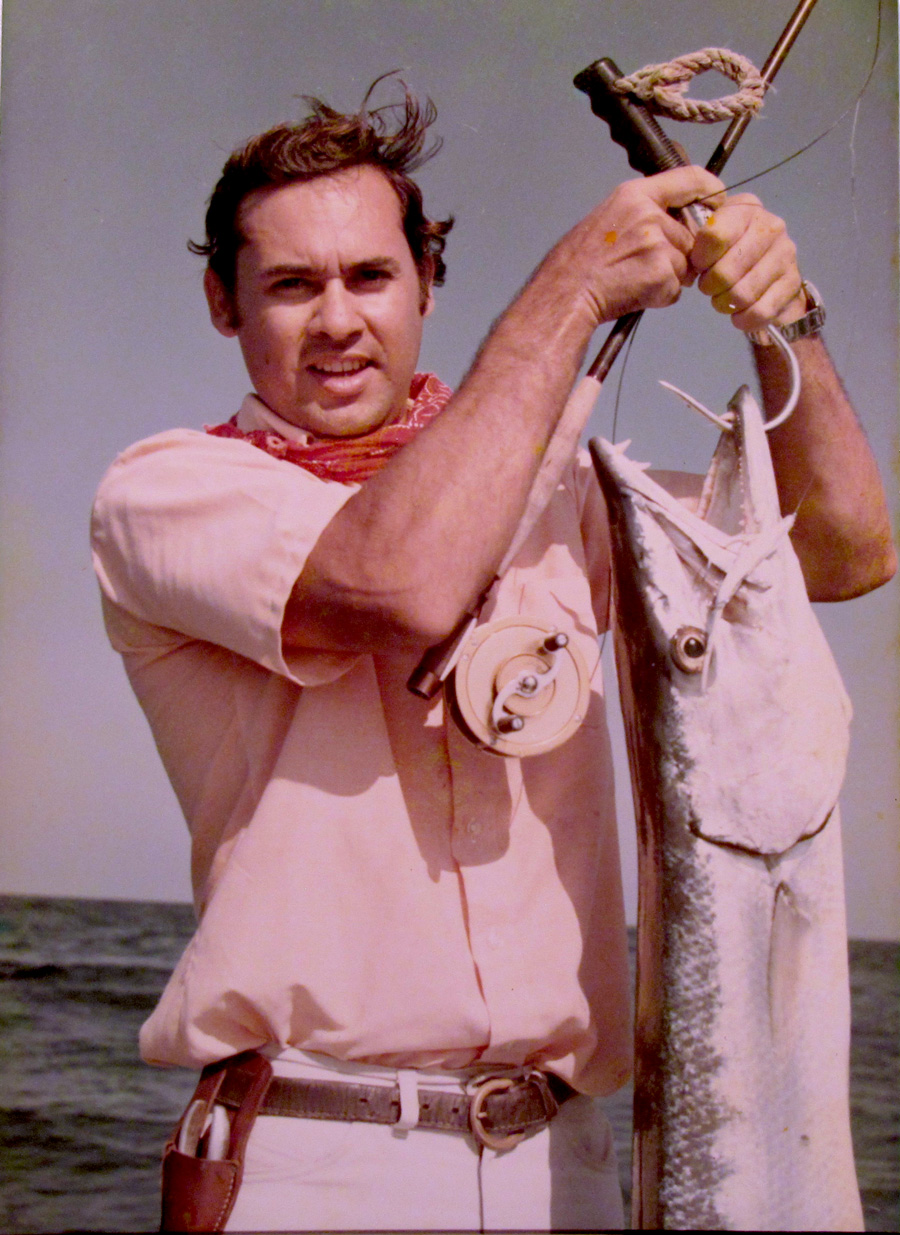
Chico Fernandez circa 1970
In the winter of 1988, I hosted a trip of 12 anglers to Los Roques, Venezuela. Fishing was fantastic in those days. On the last day of the trip, four of us rode a 24-foot panga to a large sandy flat that had a very sharp drop-off at one end. There were schools of bonefish everywhere, so my anglers got off and started wading after them right away. I stayed on the panga, eating half a sandwich while standing on the tip end of the bow. Soon, everyone was hooked up, and schools of bonefish where racing all over the flats as far as I could see. It was fun to watch.
Then I saw a very large dark fish in the distance. It was following one of the schools of bonefish. I couldn’t see it well enough, but it was either a shark or a large barracuda.
I had a feeling it was a ‘cuda. So I grabbed my 9-weight rod with an old Seamaster Mark II and a ‘cuda fly with No. 4 wire. I had been looking all trip long for that big barracuda, and this could be my chance.
I got off the panga, and once on the hard sand, I had to wade a long time before I got within casting range. And then I could see it clearly; it was a big ‘cuda. My heart was pumping, my throat was dry, and I have to admit that I was nervous.
It wasn’t too windy, and I was up wind of the fish anyway, so it was a fairly easy 60-foot cast. The fly landed 8 or 10 feet from the fish. The ‘cuda was excited upon seeing the fly, but still, as usual, followed the fly halfway to me before taking it. Once hooked, it made a couple of short runs, 20 yards or so, and then made the most spectacular jump I can ever remember out of a ‘cuda. It was a long jump that had to be more than 20 feet. I’ll never forget it.
But a few minutes into the fight, the ‘cuda decided to leave the flat and headed for the deep drop-off at high speed. There was nothing I could do about it except wade after the fish as fast as I could, which wasn’t very fast, so I was quickly losing line. Meanwhile, the ‘cuda got to the edge of the drop-off, only a few feet from the staked out panga, and kept going. Several of the anglers and the guides saw her go by. The next time it jumped, it was an estimated 150 yards away. The big fish was running infinitely faster than I could move by wading.
I kept losing line, and by the time I got to the panga, I could see the bottom of the reel with only a few turns of backing left on it. It was a big effort to climb on the panga’s tall freeboard, but as soon as I did, the engine was running and we were chasing the ‘cuda.
Now I could start to gain line—very slowly since the reel’s arbor was about the size of a quarter. But eventually I was back in the fly line, and by then the fish had sounded, so now it was just a matter of time. Eventually, I was able to bring the fish to the boat and land it. It tipped the guide’s old scale to 34 pounds. And as I held it for a few quick photos, I knew I would never forget this fish. Not even if I ever caught a bigger one. Which I haven’t.
For pure excitement in shallow water, fly fishing for big barracudas is hard to beat. You are looking for this big alligator-like, sinister-looking fish, often sitting still on the water’s surface. It’s exciting when you finally spot one.
Then, when it chases the fly, it will be pushing a big wake behind it. Equally visible is the strike, often very fast and with a big splash and lots of foam. The whole thing has vicious written all over. Because the barracuda is big and fast, it has the ability to make some long runs. And a large ‘cuda is capable of some of the most spectacular jumps you’ll ever see. They can be very high as well as very long, and all this happens as your reel is screaming. Tarpon also can make spectacular jumps, of course, but ‘cuda jumps have their own personality. It’s different. It’s cool.
There are times when the barracuda decides to turn right or left in middle of a run, and now your fly line starts to cut through the water, leaving a big tail of foam. It’s a sight you won’t soon forget.
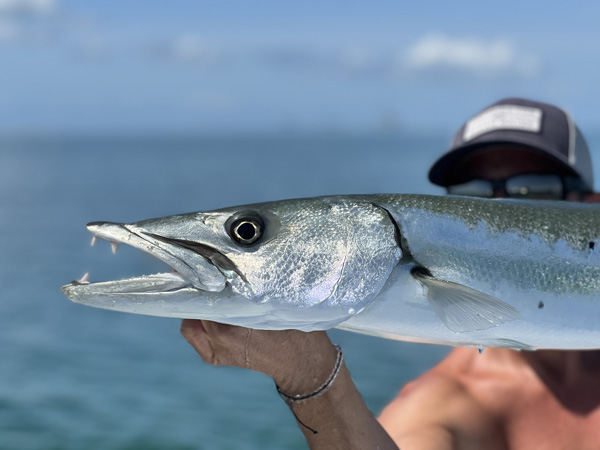 A big barracuda is probably the most underrated gamefish in the bonefish flats—a truly unsung hero. On the other hand, sight casting to a big ‘cuda in shallow water is not easy, and that, too, makes it exciting
A big barracuda is probably the most underrated gamefish in the bonefish flats—a truly unsung hero. On the other hand, sight casting to a big ‘cuda in shallow water is not easy, and that, too, makes it exciting
Sphyraena barracuda is commonly known as the great barracuda. The extent of its worldwide habitat is phenomenal. They can be found from extremely shallow bonefish flats to reef areas and open ocean. I’ve taken them in a foot of water, trolling in blue water for marlin and dolphin, and right on the bottom in more than 200 feet of water while deep jigging for grouper and snapper. They go anywhere they want.
And they grow large. The largest on record is 102 pounds, taken in Africa. But fishing the flats today, one close to 20 pounds is a good one, and 30 or larger is a trophy.
More than 40 years ago, I was wading after a school of bonefish on the south end of Turneffe Atoll in Belize. Behind me, the flat dropped off to perhaps 3 feet. I had been busy stalking the school of bones, trying to get in position to cast. I don’t know why, but something made me look behind me, and when I did, I found myself looking at a giant barracuda only 20 feet away. It was right on the surface, looking straight at me. Our eyes met. Neither the ‘cuda nor I moved a muscle.
This went on for a few seconds, and then, almost instinctively, I cast the bonefish fly and passed it by the fish. It never acknowledged the cast or the fly; it just kept looking at me, obviously not afraid. I was not as confident; the fish intimidated me. Finally, after what seemed like a long time, it slowly sank to the bottom, where I could still easily see it. It was big, fat, and dark. Forgetting all about the bonefish school, I then decided to back off slowly and head to shore, where I waited for the skiff to come get me. I honestly believe the ‘cuda was bigger than 60 pounds. Later that evening at the camp, when I told my story over drinks, a couple of the old guides told me they also had seen the fish. I still think about it.
Best time of year
Barracuda don’t like hot weather, so the best time of the year for them is late fall through early spring in most places where I’ve fished, including the Bahamas and Florida.
“The best time is during colder weather, because it brings baitfish to shallow water and the ‘cudas follow them,” says Captain Alex Zapata, who loves to fish for them from Miami down through the Florida Keys. “My favorite months are February to April. November through January are also good months, providing there isn’t a severe cold front. Then everything can shut down.”
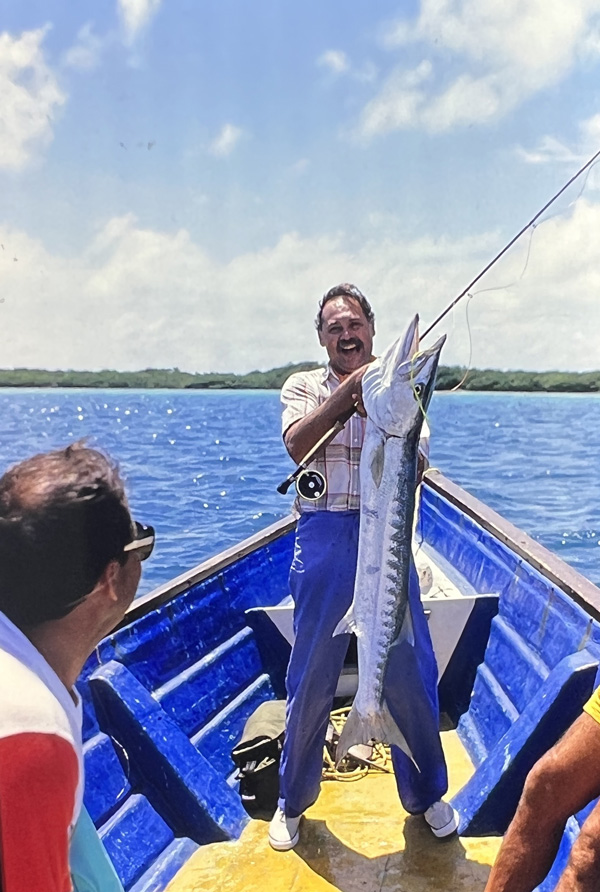
Chico Fernandez in Los Roques with a big barracuda
Looking for big ‘cudas
Good areas include deeper flats, like the areas you would fish for permit. Any light-bottom pothole is always a good place to check out.
Shallow wrecks or markers, even in 10 to 20 feet of water, also will have big ‘cudas, often visible right on the surface. And when I can’t find them, another good bet is blind casting in channels around the flats, especially on outgoing tides.
In the Bahamas one of my favorite places to look for big ‘cudas are areas with large schools of small bonefish, especially if it’s an outside flat closer to deep water. Some of the biggest ‘cudas I see in the flats are in those conditions.
“In the Keys, I love a strong incoming tide because it pushes the baitfish into the flats, and the big ‘cudas follow them,” Zapata says.
Approach and fly placement
This type of fishing is about making long casts—the longer the better. Large barracuda are very worrisome animals, and they won’t let you get close. And if they do, they simply won’t take the fly. Another reason for the long cast is that ‘cudas have the habit of following a fly for a long time before taking it. A long cast gives a ‘cuda plenty of room before it takes the fly. With a shorter cast, the fish following the fly will often see the boat before making up its mind to take the fly. Then it’s all over.
You want to cast a leader’s length beyond the fish so that the fly passes 5 to 8 feet from it. That’s ideal.
The retrieve
As a rule, ‘cudas like the fly to be moving fast. Remember that you’re using a fly that imitates a baitfish, which moves very fast when it’s trying to escape a predator. It usually can’t be too fast. I mostly use a one-hand retrieve because it’s faster than a two-hand retrieve, at least for me. And always keep the tip of the rod close to the water.
But Captain Paul Tejera mentions a situation where a two-hand retrieve makes sense. “I use a one-hand retrieve also, but there are situations, such as using a popper or casting to ‘cudas sitting on a strong current, where a steady mid-speed retrieve is called for,” he says. “Then I prefer a two-hand retrieve”.
Hook-up
As with most situations, you need to strip-strike. But often the cuda will take the fly fast, while still coming toward you, creating lots of slack. In this case, you need to use both the strip strike and a rod strike to absorb the extra slack and be able to set the hook.
Clearing line and the fight
A big ‘cuda can move very fast, especially in short bursts—like a cheetah. So when you set the hook, be ready to see your fly line leave the deck lightning fast. Also, keep the rod tip low to the water when clearing the line. It reduces the possibility of any slack, and helps keep tension on the line.
The fight in the flats won’t be long; those super-fast runs and acrobatic jumps soon take their toll. The same fish in deep water will fight a bit longer, but still not real long.
Land and release
By the time a big ‘cuda is next to the boat, it is exhausted. I much prefer to handle them by hand as opposed to lifting them by lip-gaffing, which is not good for any fish.
“I handle the big ‘cuda like it’s a bonefish,” Tejera says.
I like that philosophy. Be careful, however, because a barracuda can cut you to ribbons. If you are with a guide, let the guide handle the fish. Using gloves may also help. And to remove the hook, I always use one of the many long tools available for the task. Just be careful.
Finally, take your time reviving the fish before you let it go. Sharks are usually nearby.
Barracuda flies
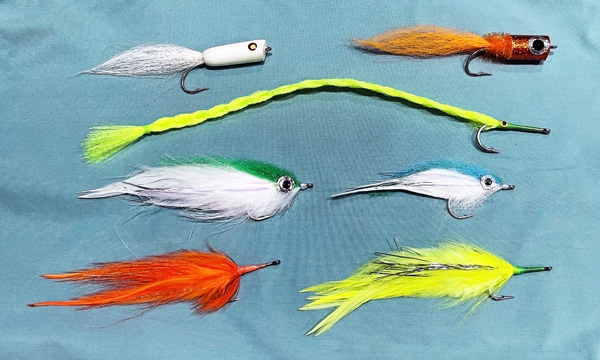
Some of Chico’s cuda flies
When selecting a fly for big barracudas, remember you have to be able to cast it far, generally in the wind, and with some degree of accuracy. So don’t be tempted to select a fly that is too big or too bulky. I prefer a short-shank hook to a long shank because they are lighter for the same size gap and have better hooking capabilities. But certain streamer and popper patterns that I like require a long-shank hook, so I still use them when I can afford to accept the trade-off.
Stinger hooks—adding a second hook to the fly—can be effective. Barracuda often strike in the middle of the fly, trying to cut the fish in half, causing them to miss the main hook up front. But these flies are heavier, so it’s harder to make that long cast that is so important. I also don’t think these flies swim as naturally, so you get more refusals, especially in areas that have a lot of pressure. Personally, I don’t use them.
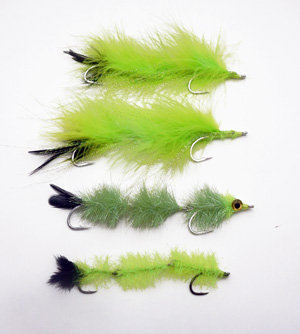
When selecting a fly, just remember that a big ‘cuda’s diet is mainly fish, not shrimp or crabs. Good choices are the classic baitfish patterns with big eyes in a variety of light colors with a darker back. I also love an all-white, all-orange or all-chartreuse fly. All patterns should have some flash as an attractor. In terms of size, most of my big ‘cuda flies are about 5 to 6 inches in length.
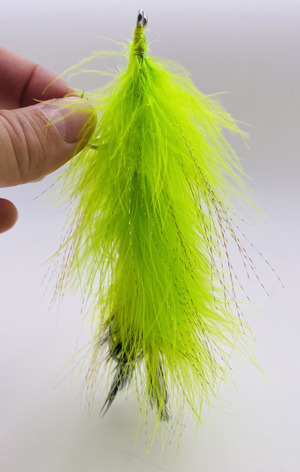
Another popular pattern is tied with braided hair, long and skinny, often on a long-shank hook. It may have painted eyes and epoxy on the front of the hook. It has taken lots of ‘cudas over the years. But somehow it’s not my first choice.
I also like a long popper, especially for blind casting in deeper flats, channels, or around shallow-water wrecks. A popper is a great dinner bell.
Fly rod, reel, and line
I like 9- and 10-weight rods because their fly lines are heavy enough to cast the weight of a big fly and wire bite tippet a long distance, but they’re still light enough that I can cast them all day if needed.
Any reel that balances with a 9-weight or 10-weight is going to have more than 200 yards of backing, which is more than enough to stop most barracuda.
A weight-forward floating line is all you need. If you are a good caster and can carry a lot of line in the air, then a line with a long belly would help you make longer casts. Also, you can try a clear weight-forward floating line so that the line is less visible to the fish. You may not be able to see the fly line in the air as well, but the big fly would be easy to see during the false casting, and that’s good enough. I often use them with good results. And they’re perfect for blind casting.
Leaders
A 10-foot leader with more than 50 percent butt section will perform well, although I usually prefer 60 percent butt section. If the fish are spooky and you’re a good caster, go to a 12-foot leader, or better yet, go to a clear floating fly line. Tippets from 12 to 20 pounds are ideal. My preference is usually 16 pounds.
The wire bite tippet can be plain No. 4 or No. 5 wire or any of the plastic-coated cables that can be tied like monofilament. They both work. But don’t use a very long bite tippet, because it’s harder to cast and you’ll get more refusals, especially from the bigger fish. My wire bite tippet is usually 4 to 7 inches, depending on conditions. That’s usually long enough that the ‘cuda probably won’t get to the mono tippet if it swallows the fly, but light enough that I can still make a long cast. If conditions are making it tough for me to make the long cast, I’ll usually reduce the wire’s length to 4 inches to reduce weight.
Be prepared
If you really want to catch a big barracuda, the most important advice—besides practicing a long cast—is to have a rod in the boat rigged and ready strictly for barracuda. Generally, when you see one while fishing for bonefish or some other species, there’s no time to take out a heavier rod, check the leader, find the wire, tie it to the tippet, and so on. There’s just not enough time.
But if you have a 9- or 10-weight fully rigged and ready, it’s just a matter of dropping the bonefish rod, taking out the cuda rod, and starting your false cast.
If you are committed to barracuda fishing and not concerned with other species, then I suggest having two rods rigged with different flies—maybe a streamer on one rod and a popper on another. When you get to a deep channel that looks good, take out the popper ring the dinner bell. When you go back to a shallow area, it may be preferable to go back to the streamer fly. And if you get a refusal, you can quickly pick up the other rod and offer the fish something different.
Eating barracudas?
If you are considering a barracuda to eat, keep in mind that ciguatera poisoning is an issue. It occurs more often in larger fish, but can also be present in smaller fish. Ciguatera poisoning is caused by eating a fish that contains toxins from a marine mircoalgae. People who have ciguatera may experience nausea, vomiting, and neurological symptoms such as tingling in the extremities. Symptoms usually go away in a few days or weeks, but sometimes they can last for years. Ciguatera has no cure, but it can be treated.
My advice is to release the ‘cuda and eat a mangrove snapper.


